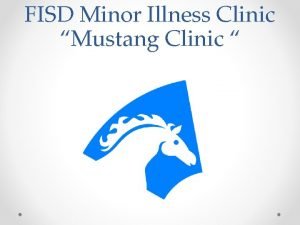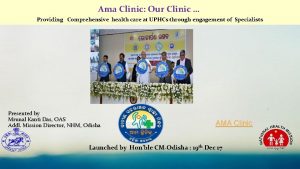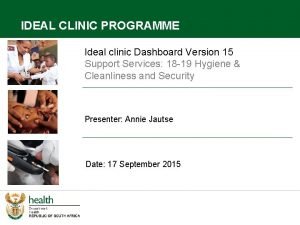When The World Shows Up At Your Clinic






























- Slides: 30

When The World Shows Up At Your Clinic Door: Addressing Chronic Hepatitis B in Immigrant and Refugee Communities Robin Councilman M. D Hennepin County Medical Center North. Point Health and Wellness Center

Activity Disclaimer ACTIVITY DISCLAIMER Dr. Councilman has no conflict of interest. 2

Learning Objectives • Participants will be able to identify common ethnic groups at increased risk for chronic Hepatitis B. • Participants will understand the differences in transmission and course in chronic Hepatitis B compared to acute Hepatitis B. • Participants will understand how to identify patients at risk for chronic Hepatitis B in their own patient populations and know how to screen and follow those patients. 3

OUTLINE § § § 4 Definition The scope of the problem Barriers to a solution Overcoming those barriers A primary care approach to managing Hepatitis B

Hepatitis B Definitions • Acute: Hepatitis B s. Ag + for less than 6 months with or without acute illness c/w viral hepatitis. • Chronic: Hepatitis B s. Ag + for more than 6 months 5

Scope of the Problem Acute Hepatitis B • Decreased 64% from 2000 to 2011 • In 2011 2, 890 cases nationwide 6

Scope of the Problem Chronic/Endemic Hepatitis B • 2012 estimated prevalence of chronic Hepatitis B at 2. 2 million in US • Worldwide WHO estimates 350 million 7

Why is this so Important? • 65% of those infected with Hepatitis B in the US do not know it. • 25% of those with chronic Hepatitis B will die of liver disease or hepatocellular carcinoma (HCC) 8

Who is at Risk? CDC: “Immigrants, refugees, asylum seekers, internationally adopted children and US born children of those groups from regions of high endemicity. ” 9

Areas of High (>8%) or Intermediate (2 -7%) endemicity • • • 10 All Asian Countries All African Countries All South Pacific Islands Middle East except Cyprus and Israel Europe: Malta, Spain, Portugal, Greece, all Eastern except Hungary

Areas of High/Intermediate “Endemicity” con’t • South America: Ecuador, Guyana, Sudnam, Venezuela, Bolivia, Brazil, Columbia, Peru • Caribbean: Antigua/Barbuda, Dominica, Granada, Haiti, Jamaica, St. Kitts/Nevis, St. Lucia, Turks/Caicos • Central America: Guatemala, Honduras • Arctic Native Populations in Alaska, Greenland, Canada 11

Better way of remembering Everywhere except North America, Australia, Northern and Western Europe, and some parts of South America have high or intermediate levels of Hepatitis B. 12

The Face of those Most at Risk Study of Asian and Hispanic patients in CA showed that low income/LEP (limited English proficiency) patients are at increased risk for HCC in both populations and it showed similar increased risk for those in “enclave” neighborhoods (high LEP, high immigrant numbers) 13

Barriers to a Solution • • 14 Education of patients at risk Education of providers Access to Care Inadequate testing/lack of follow up to testing

Patient Education • • 15 Educating about “wrong” disease “There is nothing that can be done” Community stigma Patient distrust

Provider Education • Alphabet soup of labs • Education about “wrong” disease • Lack of knowledge about who is at risk 16

Barriers to Access to Care • • 17 Lack of insurance Limited English Proficiency Lack of “usual source of care” Cost of testing

Problems with Testing • • 18 Wrong tests done Tests never followed up on Providers presume testing has been done and was negative

Overcoming these Barriers • Start thinking, talking, and teaching about chronic/endemic/perinatal Hepatitis B • Community education • Provider education • Consider Hepatitis B testing as HCM • All patients who meet CDC screening criteria should have Hepatitis B status clearly documented in chart-if not, TEST 19

Managing Hepatitis B in Primary Care • Establish relationship with patient and community • Test in all new patients and any patient having labs/HCM with no prior documentation • Educate with testing regardless of result • Reach out to family of those who are + 20

Interpreting the tests Hep B s Ag and Ab • Ab+ Ag- Immune • Ab- Ag- At risk-opportunity to immunize • Ab- Ag+ Hep B (if same in 6 months- chronic) • Ab+ ? ? ? Repeat 21

Hepatitis B in Primary Care Education • Who else needs to be tested • How patient did/didn’t get it • Course of Hep B (silent disease mostly) • Who is at risk • How to minimize risk • F/u and treatment possibility 22

Hepatitis B in Primary Care Secondary Prevention • • 23 Alcohol education Hep A vaccination if needed Check Hepatitis C Healthy lifestyle (including med usage)

Hepatitis B in Primary Care Follow-up Testing Initial: LFTs, CBC, PT/PTT, Hep B quantitative DNA level, AFP, ultrasound q 6 -12 months: ALT, AFP, quant, ultrasound 24

Hepatitis B in Primary Care Who to Refer • • 25 Everyone? All who wants a referral High risk FHx Abnormal labs/ultrasound Hepatitis B level > 10, 000 Candidates for treatment Pregnant women

Hepatitis B in Primary Care Barriers to Specialty Care • Liver biopsy? Standard for assessing the level of inflammation, cirrhosis, fibrosis prior to treatment “If liver biopsy is not feasible, non-invasive assessment of liver fibrosis is an alternative” • Access to specialty care • Trust/language/etc. 26

Who Should Get Treatment • Rapidly deteriorating liver function • Rapidly progressing cirrhosis • High risk patients with compensated cirrhosis • Immunosuppressed • Pregnant women with high levels 27

Who Might Get Treated • High DNA levels with evidence of active inflammation/fibrosis 28

References (Hepatitis B Management) Cohen C, Holmberg SD, Mc. Mahon BJ, Block JM, Brosgart CL, Gish RG, et al. Is Chronic Hepatitis B Being Undertreated in the United States. Journal of Viral Hepatitis. 2011 Covin H, Mitchell A. Hepatitis and Liver Cancer: A National Strategy for Prevention and Control of Hepatitis B and C. Institute of Medicine. 2010 Kowdley KV, Wang CC, Welch S, Roberts H, Brosqart CL. Prevalence of Chronic Hepatitis B Among Foreign-born Persons Living in the United States by Country of Origin. Hepatology. 2012. Liaw YF, Kao JH, Piratvisuth T, Chan HLY, Chien RN, Liu CJ, et al. Asian Pacific Consensus Statement on the Management of Hepatitis B: a 2012 Update Hepatol Int. 2012. Lok, A, Mc. Mahon B, Chronic Hepatitis B: Update 2009. Hepatology. 2009. Sorrell MF, Belongia EA, Costa J, Gareen IF, Grem JL, Inadomi JM, et al. National Institutes of Health Consensus Development Conference Statement: Management of Hepatitis B. Ann Intern Med. 2009. Winbaum C, Williams I, Mast E, Wang W, Finelli L, Wasley A, et al. Recommendations for Identification and Public Health Management of Persons with Chronic Hepatitis B Virus Infection. MMWR 2008 29

References (Confounding Factors) Callen J, Georgiou A, Li J, Westbrook J. The Safety Implications of Missed Test Results for Hospitalized Patients: A Systemic Review. BMJQS. 2010. Chan E, Yang, J, Alfaro-Velcamp T, So SK, Glaser SL, Gomez SL. Disparities in Liver Cancer Incidence by Nativity, Acculturation, and Socioeconomic Staus in California Hispanics and Asians. Cancer Epidemiolo Biomarkers Prev. 2010. Cheng EM, Chen A, Cunningham W. Primary Language and Receipt of Recommended Health Care Among Hispanics in the United States. Journal of General Internal Medicine. 2007. Derose KP, Escarce JJ, Lurie, N. Immigrants and Health Care: Sources of Vulnerability. Health Affairs. 2007 . Forrest C, Shadmi E, Nutting P, Sarfield B. Specialty Referral Completion Among Primary Care Patients: Results From the ASPN Referral Study. Ann Fam Med. 2007. Medscape: Family Medicine. Screening for Hepatitis B Virus Infection by Primary Care Physicians in New York City: Are Screening Recommendations for Persons Born in Endemic Countries Being Followed? http: //www. medscape. org/viewarticle/732116_7 30
 When god shows up he shows off
When god shows up he shows off Give us your hungry your tired your poor
Give us your hungry your tired your poor Hình ảnh bộ gõ cơ thể búng tay
Hình ảnh bộ gõ cơ thể búng tay Frameset trong html5
Frameset trong html5 Bổ thể
Bổ thể Tỉ lệ cơ thể trẻ em
Tỉ lệ cơ thể trẻ em Voi kéo gỗ như thế nào
Voi kéo gỗ như thế nào Tư thế worms-breton
Tư thế worms-breton Chúa yêu trần thế
Chúa yêu trần thế Môn thể thao bắt đầu bằng từ đua
Môn thể thao bắt đầu bằng từ đua Thế nào là hệ số cao nhất
Thế nào là hệ số cao nhất Các châu lục và đại dương trên thế giới
Các châu lục và đại dương trên thế giới Công thức tính độ biến thiên đông lượng
Công thức tính độ biến thiên đông lượng Trời xanh đây là của chúng ta thể thơ
Trời xanh đây là của chúng ta thể thơ Cách giải mật thư tọa độ
Cách giải mật thư tọa độ 101012 bằng
101012 bằng độ dài liên kết
độ dài liên kết Các châu lục và đại dương trên thế giới
Các châu lục và đại dương trên thế giới Thể thơ truyền thống
Thể thơ truyền thống Quá trình desamine hóa có thể tạo ra
Quá trình desamine hóa có thể tạo ra Một số thể thơ truyền thống
Một số thể thơ truyền thống Bàn tay mà dây bẩn
Bàn tay mà dây bẩn Vẽ hình chiếu vuông góc của vật thể sau
Vẽ hình chiếu vuông góc của vật thể sau Biện pháp chống mỏi cơ
Biện pháp chống mỏi cơ đặc điểm cơ thể của người tối cổ
đặc điểm cơ thể của người tối cổ Ví dụ về giọng cùng tên
Ví dụ về giọng cùng tên Vẽ hình chiếu đứng bằng cạnh của vật thể
Vẽ hình chiếu đứng bằng cạnh của vật thể Fecboak
Fecboak Thẻ vin
Thẻ vin đại từ thay thế
đại từ thay thế điện thế nghỉ
điện thế nghỉ





















































